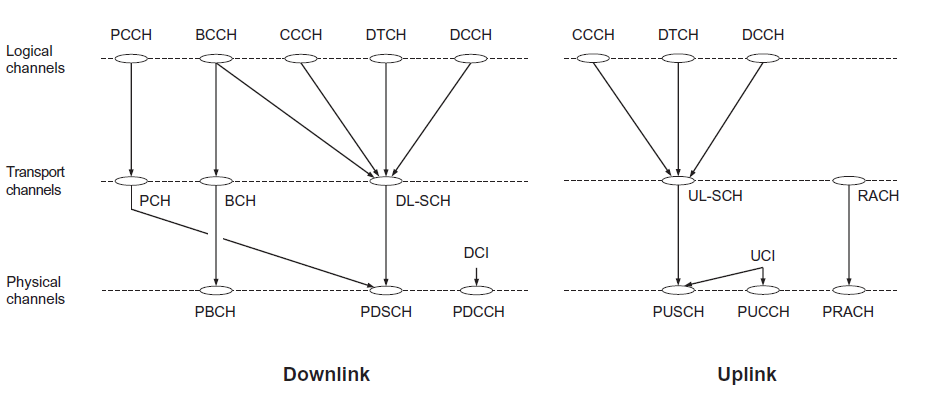Different Channels in 5G NR — Part 1

There exist three types of channels in the 5G Cellular Communication system:
- Logical Channel: Further divided into Control and Traffic channels.
- Transport Channel.
- Physical Channel: Carries the actual data on the air interface.
In this part, we discuss 5G NR Physical Channels. The logical and transport channels are discussed in the Part-2 of this series.
The physical channels are the closest to the actual over-the-air transmission. The Transport Channel payloads are mapped into the Physical Channels (see the diagram above).
In total, there are six Physical Channels. Two channels carry most of the control information (like PDCCH, PUCCH). PBCH is responsible for tasks like UE-synchronization and broadcasting. PRACH ensures channel access. Actual information payloads (like text messages, audio/video call-data, web-stream etc.) are carried over shared channels (PDSCH and PUSCH). So let's get into quick details.
1. Physical Broadcast Channel (PBCH):
The main task for PBCH is to broadcast Master Information Block (MIB) from gNB to ALL UEs.
PBCH is transmitted with fixed QPSK modulation with 80 ms periodicity, with multiple repetitive transmissions within this period. MIB is most essential for UE to start decoding PDCCH, which in turn helps UE to decode PDSCH. As soon as a UE turns on, it looks for MIB.
PBCH is almost always accompanied by the Synchronization Signals (SSS and PSS) for UE-and-gNB time-frequency synchronization. Together PBCH/SS is called SSB block (After decoding SSB Block, a UE can read the information in the SIB1 block which contain information for Initial Bandwidth Part for initial access). SSB is always 4 OFDM symbols in time and 20 RBs in the frequency domain.

2. Control Channels (PDCCH, PUCCH):
Physical Downlink Control Channel (PDCCH) carries Downlink Control Information (DCI) as its payload. The PDCCH uses a QPSK modulation format. PDCCH is responsible for scheduling resources for the transmissions on the PDSCH and PUSCH, uplink power control etc. The type of info that PDCCH carries depends on DCI formats and the RNTI types (details omitted as it is a huge topic on its own).
Note that the PDCCH is not linked to any upper layer channel and only carries DCI as its payload (see the figure at the top).

Physical Uplink Control Channel (PUCCH) carries Uplink Control Information (UCI). In some cases, UCI may also be sent on the PUSCH. (Note that contrary to UCI, its counterpart in DL i.e. DCI is always sent on the PDCCH.)
3. Data-carrying channels (PDSCH, PUSCH):
Physical Downlink Shared Channel (PDSCH) and Physical Uplink Shared Channel (PUSCH) are the main data carriers.
You can see from the Fig.1 picture that several upper-layer channels like PCCH, BCCH, DTCH etc. all are consequently carried as a PDSCH payload PDSCH (vice versa goes for PUSCH for its respective upper layer channels)
The PDSCH uses a flexible Modulation and Coding Scheme (MCS) dependent upon the link conditions, i.e. signal-noise-ratio. Allowed modulation schemes are (QPSK, 16-QAM, 64-QAM, 256-QAM).
PUSCH is the counterpart of PDSCH and is used for uplink data transmission. PUSCH is, in many ways, similar to PDSCH but only has the reverse direction to the latter. One noticeable change in PUSCH is that it can also carry Uplink Control Information (UCI) as well. This is opposed to PDSCH which cannot carry UCI’s counterpart i.e. DCI.
4. Random Access Channel
A physical Random Access Channel (PRACH) is used for channel access in a 5G cell. A device starts random access by sending Random Access Preamble (PRACH preamble or MSG-1) over this channel.

References
[1] E. Dahlman et al. “5G NR the Next Generation Wireless Access Technology”, Academic Press 2020
